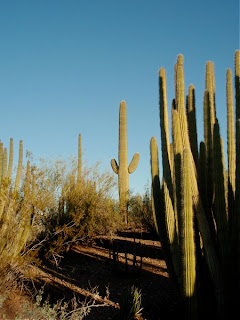For our final few days in Costa Rica we chose to visit Manuel Antonio reserve towards the southern end of Costa Rica's Pacific coastline. At 683 hectares, this is Costa Rica's smallest national park, but also the most visited. To lessen the impact of visitors, only 600 a day are allowed into the park, and once 300 have entered, more are allowed in only as others leave. Line-ups are common, especially on sunny days when many take a picnic lunch and spend the day on one of the beautiful beaches ringing the reserve.
The park is closed on Mondays, so we decided to drive down on that day, stay overnight close by the entrance and be among the first to enter when the gates opened at 7 a.m.
We meandered down to the coast, passing an occasional high-end resort tucked away in the jungle.
This one had an enigmatic statue monitoring traffic along the road.
There were also some much more basic accommodations.
Once past Jaco, which we had visited the week before, we came to many plantations of African palms. When bananas were threatened by a blight some decades ago, farmers replaced them with the palms. Harvesting the huge palm nuts for their oil is less labour-intensive and the crop is less time-sensitive than bananas
We assumed that the little dwellings we kept passing on open ground between the plantations were for the farm labourers.
At one point we saw a group of workers, driving their oxen along a side road. I wondered how they would react to being snapped, and was relieved when they smiled and mugged for the camera. It is interesting how plain and practical their carts were compared with the decorative ones for the tourist trade that we'd seen for sale in Sarchi.
We stopped at a simple beachside hotel and restaurant for lunch.
It was much hotter and more humid on the coast than it had been in the highlands; we were glad of the shade around the bar.
The restaurant grounds gave directly onto the sand...
... so we were able to take a short stroll along the beach before continuing on our journey.
Michael, as always, had his sketchbook at the ready.
When we arrived in the little town of Manuel Antonio, we found accommodation just around the corner from the park entrance. It was pretty basic, but clean and with a modern bathroom that included ample hot water.
After getting our bearings, we sat in a restaurant drinking margaritas and watching the sunset over the ocean. A dinner of fresh fish rounded things off nicely.
Back in our room we watched TV: familiar movies like Mamma Mia complete with Spanish subtitles were doing wonders for our vocabulary. Besides, one of the deficiencies we had discovered in our room was a lack of sufficient light to read by. (Another was a lack of mosquito screening!)
Early the next morning we grabbed a coffee and a pastry from a little hole-in-the-wall and then joined a knot of people waiting for the park gates to open. We paid our US$10 each and set off along the main trail, seeing an occasional huge blue morpho butterfly drifting past like a blinking neon light. Suddenly a couple of white-faced monkeys came hurtling down the path, and tore off into the foliage. They were so fast and gone so quickly I had no time to point my camera, much less focus. As it turned out, they were almost the only wildlife we saw, although a tourist guide hired by others kindly pointed out a basilisk sunning itself on a tree trunk. It was so well camouflaged we would never have noticed it without his intervention.
Apart from that we had to be content with pawprints on one of the beaches. Considering the size of them, I'm not sure I would have cared for a face-to-face meeting.
In spite of the early hour, the humidity rose with every minute, and the exertion of climbing a few steep ridges soon drenched us in sweat. The beaches, however, were picture-postcard quality.
In spite of the heat, I opted not to swim as I didn't want to hike out with sand in my shoes. Michael took the plunge but reported that the water was "pee-temperature" and not very refreshing.
When we emerged from the park, there was indeed a line-up of people waiting their chance to get in; we were doubly glad we'd made the effort to go early.
Leaving Manuel Antonio we checked out the plane, now incorporated into a restaurant, that Oliver North had acquired during the Iran-Contra scandal to run drug supplies into Nicaragua.
We also stopped for an hour or so at the charming little town of Quepos where every storefront was colourful with paint,
and flowers,
or brightly-coloured wares.
Even the gutters were brimming with colour.
After the long drive back to Atenas, we were happy to spend the next day just hanging around the house, enjoying the peace and the sunshine. It was still dark the following morning when we left for the airport and the flight home.


































